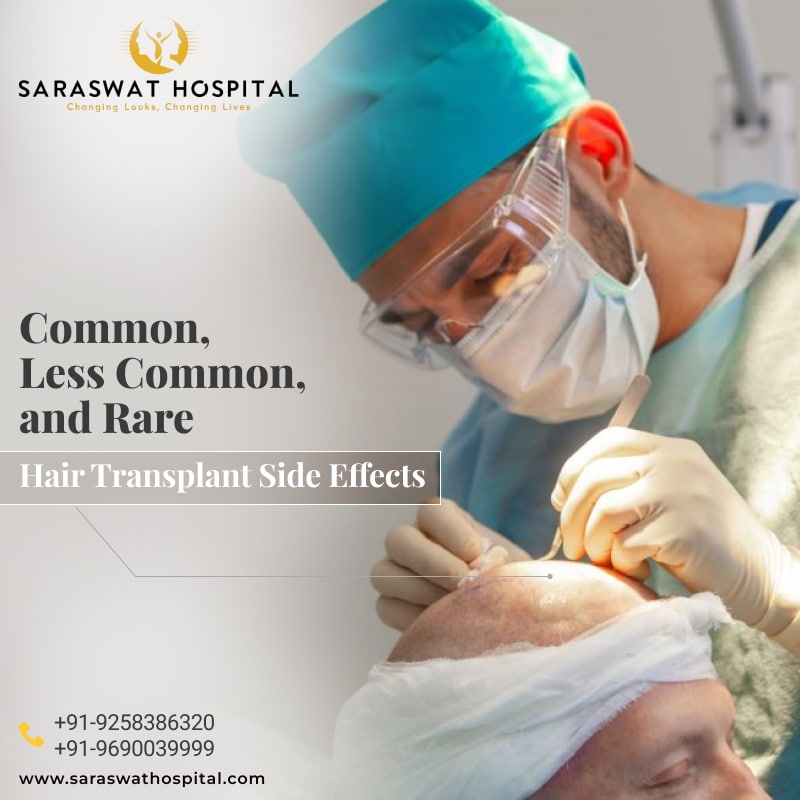Hair transplants are a popular hair restoration treatment. It is effective for people who are suffering from baldness or thinning hair. Along with the successful results, some unfortunate instances of hair transplant side effects are also available on the internet that can make you think twice about the procedure. Just like any other surgical procedure, hair transplants may also come with some side effects or risks. However, if the procedure is done by expert surgeons in an advanced clinical setting using top-notch sterile medical equipment, it’s possible to lower the chances of side effects or risks.
To avoid hair transplant side effects and get satisfactory, natural-looking results, it is important to choose the right clinic and consult qualified physicians. The hair transplant black market practises increase the chance of side effects and other complications. According to the 2022 Practice Census Results by ISHRS, nearly 25% of their repair cases are the results of previous black-market hair transplants. So, before undergoing this procedure, do complete research, choose the best hair transplant clinic in India (check the affiliations of the clinic and the qualifications of the doctors), read previous patients’ reviews, and then decide wisely.
Common Hair Transplant Side Effects
A hair transplant is a safe surgical procedure that should always be done by qualified and experienced surgeons. However, even successful hair transplants may cause some side effects. Any kind of discomfort should be reported to the surgeon on an immediate basis, and the patient should strictly follow the after-hair transplant guidelines provided by the clinic.
a. Swelling
Swelling, or ‘edema,” is a common hair transplant side effect. It typically occurs on the forehead and around the eyes and can last for two to five days. Swelling happens when fluid accumulates in the tissues around the forehead and eyes after the hair transplant surgery. This is a natural response to the trauma during the transplantation procedure.
How to Manage:
Patients can apply a cold compress to the swollen areas using a clean cloth or an ice pack wrapped in a towel and repeat the procedure several times a day (for 15–20 minutes). Also, patients can keep their heads elevated while resting, using pillows for proper neck and shoulder support. Hair transplant doctors also prescribe anti-inflammatory medications to help reduce swelling.
b. Mild Pain or Discomfort
Mild pain or discomfort is another common side effect of hair transplant surgery. Patients may experience mild pain in the donor and recipient areas due to the incisions and grafting processes. These processes can cause temporary inflammation and sensitivity.
How to Manage:
Generally, hair transplant surgeons prescribe painkillers to reduce pain and discomfort. Strictly follow your doctor’s recommendations for painkiller dosages and frequency. Also, patients should avoid activities that can increase pain, such as bending over, heavy lifting, or other vigorous activities.
c. Bleeding
Due to the small incisions made during the transplantation procedure, patients may experience minor bleeding at the transplant sites. It’s common for some minor oozing to be there for the first 24–48 hours of the surgery.
How to Manage:
Apply gentle pressure with a clean cloth or saline-water-soaked gauze. It can help stop bleeding in the transplant areas. If bleeding persists or worsens, contact your hair transplant doctor as soon as possible for further guidance. Patients should avoid activities that can increase blood flow to the scalp, such as strenuous exercise or bending over.
d. Redness
Redness at hair transplant sites is common. It results from the body’s inflammatory response to the surgical procedure. Actually, this is a normal part of the healing procedure and should disappear within a few weeks after the procedure.
How to Manage:
Keep the hair transplant area clean, avoid touching, and properly follow your doctor’s post-operative care instructions. Patients should have some patience, and the redness will subside on its own. If redness worsens or the patient experiences other symptoms such as pus or increased pain, it can indicate the chances of infection. Contact the doctor for the best help.
e. Scabbing & Crusting
When the transplant sites start to heal, patients may notice scabs or crusts forming. This is a natural part of the healing process as the body works to fill the small incisions made during the procedure. Scabs and crusts usually fall off within 10–14 days.
How to Manage:
Patients need to keep the transplant area clean. They can gently cleanse the area with mild shampoo and lukewarm water, as advised by the surgeon. Patients should not pick or scratch the scabs, as this can cause infection or damage to the newly transplanted grafts. If scabbing or crusting worsens, contact your doctor for further guidance.
f. Itching
Itching is also a common hair transplant side effect, often resulting from the healing process. When the skin recovers, new cell formation can create a sensation of itchiness. Apart from this, scabs or dryness in the transplant areas can contribute to this uncomfortable sensation.
How to Manage:
- Keep your transplanted area clean. Gently cleanse the area using mild shampoo and lukewarm water. It will reduce irritation and the chances of infection.
- Doctors also recommend soothing topical solutions such as aloe vera gel, coconut oil, and barrier repair cream (twachaa Skin Repair Barrier Cream) to keep the transplanted area moisturised.
- Patients must avoid scratching; otherwise, it can lead to infection or damage to the grafts. If you feel an irresistible feeling of itching, simply tap or pat the area to alleviate the itch.
- Hair transplant patients should also stay hydrated. Drinking enough water can help keep your skin hydrated, which can minimise itching.
If itching is severe and persistent or you are noticing signs of infection, such as increased redness, swelling, or pus, or if you are concerned about the healing procedure, contact your hair transplant surgeon as soon as possible.
Less Common Hair Transplant Side Effects
Some patients might experience less common hair transplant side effects, which we have discussed below:
a. Infection
Infection can occur if proper care and cleanliness are not maintained before, after, and during the transplantation procedure. Bacteria can enter the transplant sites, leading to infection.
Treatment:
Strictly follow your surgeon’s post-operative care instructions to keep the transplant area clean. Hair transplant doctors also prescribe antibiotics to prevent or treat infections. If you notice infection signs such as increased redness, pus, or a foul odour, inform your doctor immediately.
b. Folliculitis
Folliculitis can happen when hair follicles become inflamed. First, it may look like pimples (red, itchy bumps) around the tink pockets where each follicle grows. It can be caused by bacteria, fungus, or irritation from the hair transplantation procedure.
Treatment:
Keep the transplant area clean and avoid scratching the itchy area. Doctors also recommend OTC or prescription treatments to alleviate symptoms.
c. Numbness
Temporary numbness can occur in the donor or recipient area due to the disruption of nerves. It may last for several weeks before the sensation returns. Hair transplant does not cause brain damage; it is a safe hair restoration procedure.
Treatment:
Patients should have some patience, as numbness typically resolves on its own. If numbness persists or worsens, contact your hair transplant surgeon for further evaluation.
d. Hiccups
The exact causes of this side effect are unknown, but it can be related to anaesthesia, medications, or stress.
Treatment:
It may resolve on its own within a few days. If hiccups are persistent or severe, contact your doctor and get prescription medications to manage the symptom. Patients can also try deep breathing or meditation to help alleviate stress-related hiccups.
Check out what ABHRS-diplomat Dr. Satya Saraswat is saying about hair transplant side effects and prevention:
Rare Hair Transplant Side Effects
It’s important to be aware of all hair transplant side effects, even if they are rare.
a. Scarring
Minimal scarring is normal, but excessive scarring can occur in rare cases, especially in patients who are prone to keloids. Scarring occurs due to healing procedures or improper surgical techniques. Get treatment from the best hair transplant doctor in India to avoid side effects like scarring. Corticosteroid local injections, silicone gel sheets, or laser therapy can help reduce the appearance of scarring. Consult your doctor to determine the most suitable treatment option for you.
b. Shock Loss
Temporary hair loss around the transplant site may occur as a response to the surgery; this is known as shock loss. Due to the trauma inflicted on the surrounding hair follicles, the transplant area may lose hair. Generally, hair grows back in that area within a few months. If the situation does not improve on its own, consult your doctor for further evaluation.
c. Graft Failure
In some rare cases, transplanted hair follicles may not take root, leading to failed growth. Graft failure can be caused by graft mishandling, infection, or inadequate blood supply to the grafts. Skin disorders like alopecia areata, lichen planopilaris, etc., can lead to poor growth. To avoid such side effects, always get treatment from an expert hair transplant surgeon who knows how to handle grafts and ensure successful results.
d. Scalp Skin Necrosis
Patients who are heavy smokers or drinkers, have uncontrolled diabetes, have some coagulation disorder, or demand very high density rarely might experience skin necrosis. Patients with such health concerns should share their complete medical history beforehand with their doctors.
e. Death
Though extremely rare, there have been a few reported cases of death associated with hair transplant surgery. This can happen due to complications like anesthesia reactions, infections, or other underlying health concerns. The best way to prevent any hair transplant side effects is to choose the best hair transplant clinic in India where patients can get treatment from broad-certified and experienced hair transplant surgeons.
Conclusion
Today, we have discussed common, less common, and rare hair transplant side effects that every patient should be aware of before undergoing the procedure. Being well-informed and working with the best hair transplant doctors in India like Dr. Satya Saraswat and Dr. Preeti Saraswat can help minimize these risks and ensure a successful outcome. It’s wise to discuss your concerns with your doctor before the procedure. At Saraswat Hospital, you can consult with Dr. Satya Saraswat and Dr. Preeti Saraswat. They have been in this domain for more than 19 years and are diplomats of the American Board of Hair Restoration Surgeons (ABHRS). They are also members of the International Society of Hair Restoration Surgeons (ISHRS). To book an appointment with them, dial +919258386320 or +919690039999.








Leave a Reply